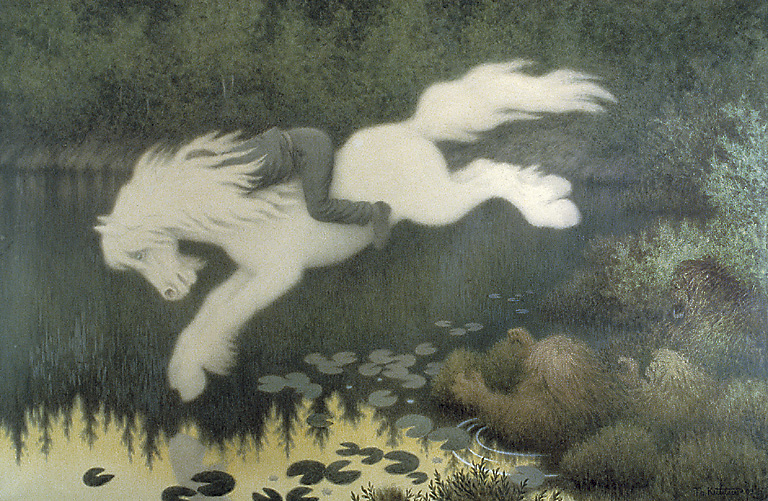
Best viewed in
Internet Explorer
PDF
Back to

Updated
06/21/2013 |
The Kelpie
|
The kelpie is a
supernatural shape-shifting water horse from Celtic folklore
that is believed to haunt the rivers and lochs of Scotland
and Ireland. It generally has grayish black fur, and will
appear to be a lost pony, but can be identified by its
constantly dripping mane. its skin is like that of a seal
but is deathly cold to the touch. In Orkney a similar
creature was called the Nuggle, and in Shetland a
similar creature was called the Shoopiltee, the
Njogel, or the Tangi .
It also appears in
Scandinavian folklore where in Sweden it is known by the
name Bäckahästen, the brook horse. In Norway
it is called nøkken, where the horse shape is often used,
but is not its true form.
In
Scottish folklore, a kelpie would lure people onto its back
and then dive into a deep lake to drown its unfortunate
rider. A kelpie if bridled by a human might be forced to do
the bidding of the rider but if the bridle should slip then
the unfortunate soul would find them in a watery grave. |
 |
The kelpie sometimes appeared as a rough hairy
man who would grip and crush travelers, but it most commonly took
the form of a beautiful tame horse standing by a stream or river. If
anyone mounted it, it would charge into the deepest part of the
water, submerging and taking the rider with it. They would sometimes
interbreed with humans' horses, and the foals were said to be fine
fleet footed horses. The kelpie was also said to warn of forthcoming
storms by wailing and howling. Rarely, kelpies could be benign.
According to the Swedish naturalist and author Bengt
Sjögren (1980), the present day belief in lake monsters in for
example Loch Ness, is associated with the old legends of kelpies.
Sjögren claims that the accounts of lake-monsters have changed
during history. Older reports often talk about horse-like
appearances, but more modern reports often have more reptile and
dinosaur-like-appearances, and Bengt Sjögren concludes that the
legends of kelpies evolved into the present day legends of
lake-monsters where the monsters "changed the appearance" to a more
"realistic" and "modern" version since the discovery of dinosaurs
and giant aquatic reptiles from the horse-like water-kelpie to a
dinosaur-like reptile, often a plesiosaur.
The following tale is a good
illustration of the brook horse:
|
“ |
A long
time ago, there was a girl who was not only pretty but
also big and strong. She worked as a maid on a farm by
Lake Hjärtasjön in southern Nerike. She was plowing with
the farm's horse on one of the fields by the lake. It
was springtime and beautiful weather. The birds chirped
and the wagtails flitted in the tracks of the girl and
the horse in order to pick worms. All of a sudden, a
horse appeared out of the lake. It was big and
beautiful, bright in color and with large spots on the
sides. The horse had a beautiful mane which fluttered in
the wind and a tail that trailed on the ground. The
horse pranced for the girl to show her how beautiful he
was. The girl, however, knew that it was the brook horse
and ignored it. Then the brook horse came closer and
closer and finally he was so close that he could bite
the farm horse in the mane. The girl hit the brook horse
with the bridle and cried: "Disappear you scoundrel, or
you'll have to plough so you'll never forget it." As
soon as she had said this, the brook horse had changed
places with the farm horse, and the brook horse started
plowing the field with such speed that soil and stones
whirled in its wake, and the girl hung like a mitten
from the plough. Faster than the cock crows seven times,
the plowing was finished and the brook horse headed for
the lake, dragging both the plough and the girl. But the
girl had a piece of steel in her pocket, and she made
the sign of the cross. Immediately she fell down on the
ground, and she saw the brook horse disappear into the
lake with the plough. She heard a frustrated neighing
when the brook horse understood that his trick had
failed. Until this day, a deep track can be seen in the
field. |
” |
|
|
— (Hellström 1985:16) |
|
|

